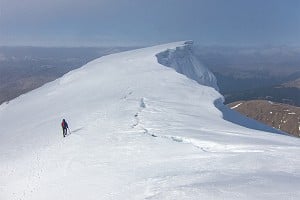
Pilates is a body conditioning method that targets the deep postural muscles building strength from the inside out by working on the deep structure of the body, promoting core stability. When climbing, appropriate engagement of your core could make a difference between succeeding or not.
Maintaining symmetry in movement is essential in Pilates practice to re-balance the body, bring it into a correct alignment and balance strength with flexibility. When climbing, the body is not in a symmetrical position most of the time and with good Pilates practice it is possible to increase range of movement in all the joints and enhance athletic performance.
Body Control Pilates is built upon 8 principles:
- Concentration
- Relaxation
- Alignment
- Breathing
- Centring
- Coordination
- Flowing movements
- Stamina
Concentration encourages you to become consciously aware of your body and how it feels, focus on the present and not on the end result.
Relaxation of the mind and body is an essential part of any Pilates session. It is vital to try to release unwanted tension from the body before and during exercises.
Correct Alignment at the start of and throughout the movement is essential. These principles combined with precision of movement is the key to strong Pilates practice. In Pilates often the exercise itself in not different from other disciplines but the way it is done makes the difference.
Breathing is one of the keys to life itself. The primary function of the respiratory system is to deliver oxygen to and remove carbon dioxide from the tissues of the body. The Pilates exercises have a set breath pattern. An inhalation occurs during one phase of the movement and an exhalation on another, breathing with the movement, encourages oxygenation of the blood. We want to resist holding the breath as this inhibits movement. Performing a difficult movement when climbing you need to use your breath to send oxygen to your muscles and brain while maintaining core engagement.
Centring refers to core stability also sometimes in Pilates referred to as the Powerhouse (which includes shoulder stability and gluteal strength). Pilates focusses on control of the body with the assistance of the deep core muscles.
Coordination (Control) the coordination of breathing and centring with the precise movements requires skill and practice. Coordinated movements also challenge body-mind connection.
Flow movements; all Pilates movements should be graceful, controlled and flowing. Pilates technique stresses that physical energy exerted from the centre (core stability) should coordinate movements of the extremities. Pilates is a flowing movement outward from a strong core.
Stamina; You can improve strength and staying power by gradually challenging your core and coordination with more advanced movements, as your practice develops, the exercises are designed to flow one into the other, building stamina.
When functional movements such as running, hill walking or rock climbing are performed, muscles do not work in isolation. All of these movements implicate a group of muscles working in a highly coordinated way to create the desired movement. In Pilates we learn how to engage or release muscles and move joints in an isolated way to allow a better understanding of full body movements.
Practising Pilates BALANCES strength with flexibility, increases bone density and improves joint mobility. A frequent Pilates practice can be very beneficial to climbers who are committed to enhancing their performance, improving their posture, gaining strength in core muscles, improving flexibility and preventing injuries.
Climbers tend to over-work shoulder joints and muscles in this complex structure, in relation to the rest of the body. The shoulder girdle supports the arms and provides attachments for several muscles involved in movements of the head. Healthy mobility and coordination of these joints and muscles in the shoulder, elbow, wrist, and hand are very important for good climbing performance, and so the exercises in this article will focus on the upper body area in order to be specific to the climbing community.
Movements at the shoulder compromise three joints:
- Glenohumeral joint between the head of the humerus and scapula
- Acromioclavicular joint between scapula and clavicle
- Sternoclavicular joint between sternum and clavicle, this is the only bony connection of the shoulder girdle and the rest of the skeleton
The shoulder area has three distinct groups of muscles. The rotator cuff, (these are the deep stabilising muscles) Subscapularis, Supraspinatus, Infraspinatus and Teres Minor which support the glenohumeral joint- they provide stability to a particularly mobile and vulnerable area and they are highly important to prevent climbing injuries.
More superficial muscles are Serratus anterior, subclavius, Pectoralis minor, Sternocleidomastoid, Levator Scapule, Rhomboids (major and minor), Trapezius - acromioclavicular joint - these muscles connect the scapula to the head, ribcage and spine. They stabilise and move the shoulder blade (scapula) when an arm movement occurs.
The largest and third group of muscles is the most superficial one: Pectoralis major, Lattissimus dorsi, Teres major, Biceps brachii, triceps brachii, Deltoid.
Here are some Pilates exercises to work your body in balance. There is no substitute for a good teacher, we would always encourage you, wherever possible, to find and join a class. All the following exercises are for beginners - any intermediate or advanced Pilates exercises we always suggest to do under a Pilates teacher's supervision.
Relaxation Position
Lie on your back on a mat. Lengthen and release your neck, allowing the natural curves of your neck to be maintained, Place a small firm flat cushion underneath your head. Bend your knees and place the soles of your feet on the mat; your legs should be hip-width apart and parallel with one another. Lengthen your arms by the side of your body on the mat with your palms facing down. Start to focus on your three points of contact with the mat, the back of your pelvis (sacrum); the back of your ribcage; and the back or your skull and encourage them to feel heavy and supported, in your lower spine you will feel less contact with the mat. Release your thighs and soften the area around the hips. Feel released in the breastbone. Feel lengthened in your neck and release this area, your jaw and your face. Allow your spine to release.
Spine Curl
Promotes sequential mobilisation of the spine and hips, while strengthening the back, abdominals, buttocks and the backs of the legs.
Align yourself in the relaxation position. Maintain an appropriate level of connection to your centre throughout (navel to spine connection).
Breathe in preparing your body to move, breathe out as you curl your pelvis underneath you, imprinting your lower back into the mat before beginning to wheel it off the mat one vertebra at a time. Roll your spine sequentially up from the mat to the tips of your shoulder blades. Breathe in and maintain this position and keep your spine elongated. Breathe out as your roll your spine back down, softening the breastbone and wheeling once again through each section. Breathe in as you release the pelvis back to a neutral position.
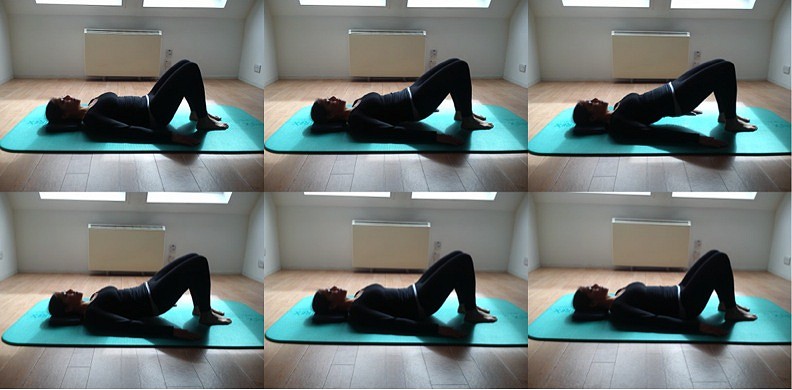
Repeat up to ten times.
Cobra Position
Helps develop spinal mobility in the upper back. Lie prone with the forehead on the mat and then bend your elbows and position your hands wider than your shoulders and above your shoulders. Your legs are wider than hip-width apart and turned out from the hips. Breathe in and prepare your body to move, breathe out as you begin to lengthen the neck to roll and flout your head and then your chest off the mat. Your lower ribs remain in contact with the mat and open your chest and focus on direct it forwards. Exhale as you return your spine bone by bone and your head back to the mat.
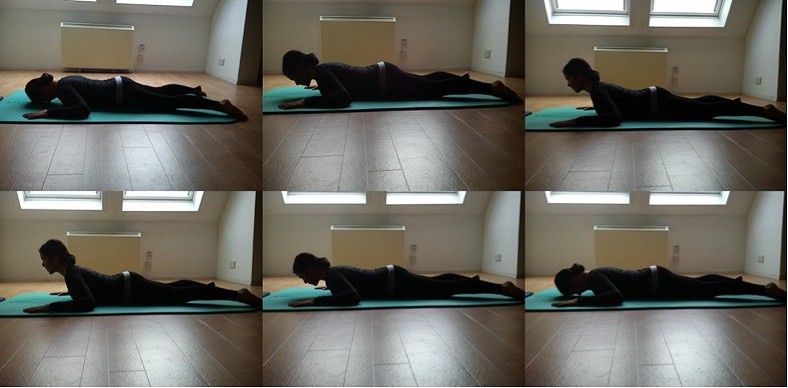
Repeat up to ten times.
Table Top
Challenges the stability of the spine and shoulder girdle.
Align yourself in four-point Kneeling Position (hands shoulders distance and underneath shoulder joints and knees underneath hip joints, spine and pelvis in neutral position)
Inhale and prepare your body to move and lengthen your spine. Breathe out and maintaining and neutral and stable spine slide one leg away along the mat directly in line with your hip joint. Your foot will maintain contact with the mat and then from the hip joint flout your leg off the mat and flow the opposite arm above your head align with your ear. Breathe in to maintain this position and as you exhale come back to the starting position.
Repeat up to five times each side.
Waist Twist
Works the muscles around your waist while promoting spinal mobility with a balanced rotation of the head, neck and torso.
Stand tall on the floor and place your feet hip-width apart in a neutral stance, neither turned out nor in a rigid parallel position. Allow your arms to lengthen down by the sides of your body. Place the weight in the centre of the feet. Lengthen your legs without bending or locking the knees. Bring your pelvis to neutral position. Flout your arms in front of your chest, bend your elbows and place one palm on top of the opposite elbow and the other hand underneath the opposite elbow. Inhale and engage your centre to prepare your body to move. Breathe out as you start a sequential movement of the spine with a turn of the head and rotate your upper spine to the right. Keep your pelvis stable and in a neutral position, breathe in to maintain the position and lengthen up the spine from the crown of your head and as you breathe out de-rotate from the lower spine to the upper spine bone by bone.
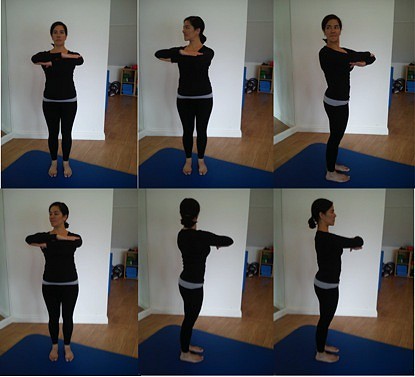
Repeat up to five times each side.
Mariana da Silva Parreira is a Body Control Pilates instructor, and completed a Level 3 matwork course in May 2013. She has continued with her training, and is now qualified to teach pregnant clients and post natal classes as well as completing her intermediate and advanced level mat training.
Mariana is a keen climber and has found that her Pilates practice has helped improve her movement. She teaches Pilates classes for climbers at TCA Glasgow on Mondays and runs general classes every day at the Otago Street Pilates studio in Glasgow.

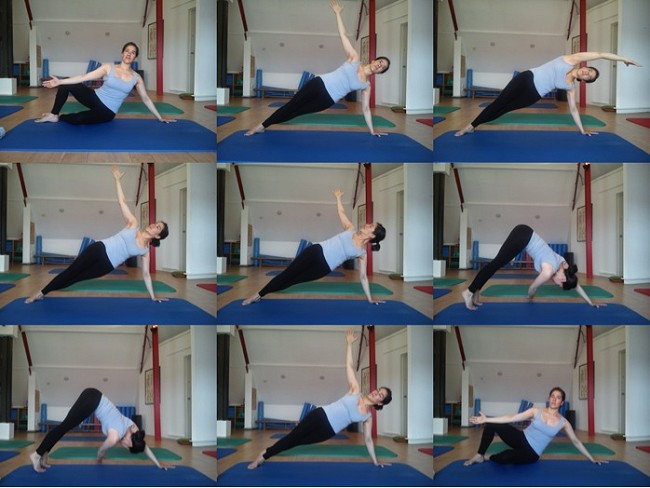

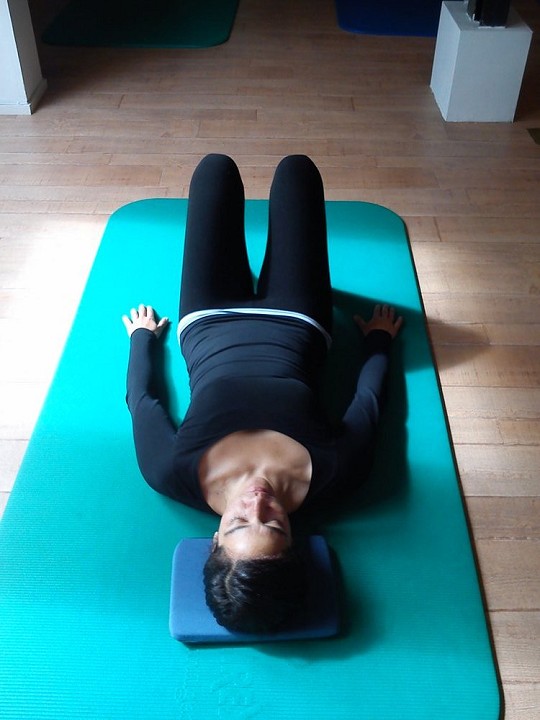

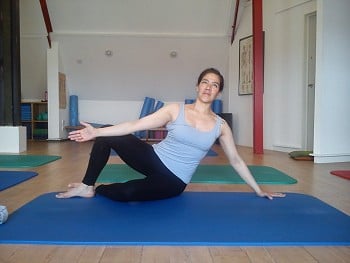
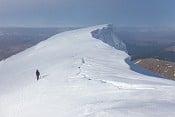
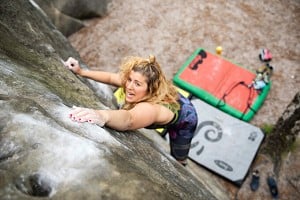

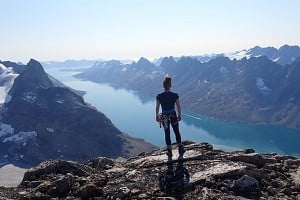
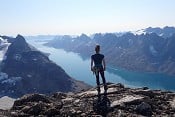








Comments